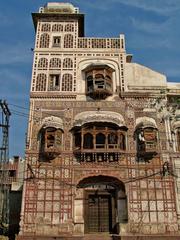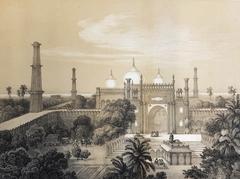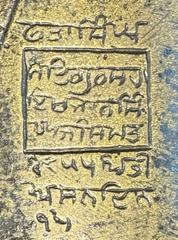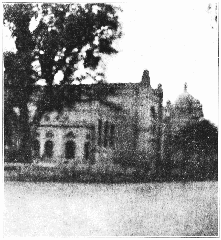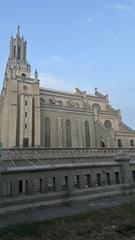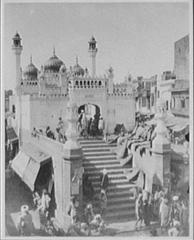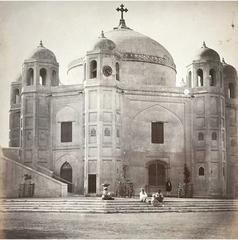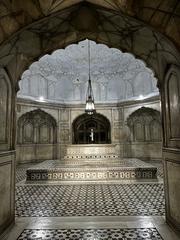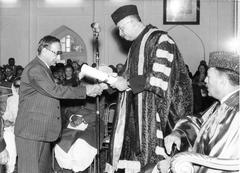Dai Anga Mosque Visiting Guide: Hours, Tickets, and Tips
Published Date: 31/07/2024
Introduction to Dai Anga Mosque
The Dai Anga Mosque, located southeast of the Lahore Railway Station in the Naulakha area, stands as a significant testament to the rich historical and architectural legacy of Lahore, Pakistan. Commissioned in 1635 by Zeb-un-Nisa, better known as Dai Anga, who served as the wet nurse to the esteemed Mughal Emperor Shah Jahan, this mosque encapsulates the grandeur of Mughal architecture and the intricate artistry of the 17th century. Dai Anga’s prominent position within the Mughal court, combined with her family’s notable roles, adds a layer of depth to the mosque’s historical narrative (Wikipedia).
The mosque’s architectural design is a harmonious blend of Mughal and Persian styles, adorned with elaborate frescoes, intricate calligraphy, and vibrant tile mosaics in colors typical of the Shah Jahan period. Over the centuries, the Dai Anga Mosque has witnessed various transformations, from serving as a military depot under Maharaja Ranjit Singh to functioning as office space during British colonial rule, before being restored to its original purpose as a place of worship (Daily Times).
Today, the mosque not only attracts worshippers but also history enthusiasts and tourists, offering a glimpse into the artistic brilliance and cultural heritage of Lahore. This comprehensive guide aims to provide detailed insights into the mosque’s historical significance, architectural marvels, visiting hours, travel tips, and more, ensuring a well-rounded and enriching experience for all visitors.
Contents Overview
- Introduction
- Historical Background
- Origins and Commissioning
- Architectural Significance
- Historical Evolution
- Restoration and Preservation
- Visitor Information
- Visiting Hours and Tickets
- Travel Tips
- Nearby Attractions
- Cultural and Religious Significance
- Dai Anga’s Legacy
- Visitor Experience
- FAQ
- Conclusion
Historical Background
Origins and Commissioning
The Dai Anga Mosque was commissioned by Dai Anga, born Zeb-un-Nisa, who was the wet nurse of Mughal Emperor Shah Jahan. The construction of the mosque began in 1635, prior to Dai Anga’s departure for the Hajj pilgrimage (Wikipedia).
Dai Anga was a prominent figure in the Mughal court, respected for her close association with the royal family. Her husband, Murad Khan, served as the Magistrate of Bikaner under Emperor Jahangir, and her son, Muhammad Rashid Khan, was renowned as one of the best archers in the Mughal kingdom. Unfortunately, her son died fighting in the service of Shah Jahan’s eldest son, Dara Shikoh (Pakistan Traveler).
Architectural Significance
The Dai Anga Mosque showcases a blend of Mughal and Persian architectural styles, featuring intricate ornamentation, elaborate frescoes, and delicate calligraphy. The mosque’s exterior is adorned with colorful tile mosaics, with dominant colors of blue, orange, and yellow, typical of the Shah Jahan period. The facade is divided into decorative panels with intricate designs created through mosaic kashi kari (Pakistan Traveler).
The mosque’s design includes domes, minarets, and a beautiful courtyard. The tall minarets rise from a square base on the two front extremities and are terminated with kiosk-like structures having cupolas. The platform of the mosque, once part of the mosque’s courtyard, is paved with beautifully laid brick flooring divided into a simple square pattern. Within the courtyard, an ablution tank has been found, and traces exist of what may prove to be a second tank (Daily Times).
Historical Evolution
Over the centuries, the Dai Anga Mosque has undergone various transformations and changes in purpose. During the rule of Maharaja Ranjit Singh, the mosque was converted into a military depot. Later, during British colonial rule, it served as a residence and office space. Henry Cope, the editor of the newspaper ‘Lahore Chronicle,’ used it as his residence. Eventually, the area, once known as Mohallah Dai Anga and populated by Mughal nobility, was acquired by the Punjab and Delhi Railway. Henry Cope sold the mosque to them for Rs 12,000, and it was converted into the office of the traffic manager, Punjab Northern State Railway (Daily Times).
In 1903, Lord Curzon expressed his dismay at the dishonored treatment of the mosque and many other Mughal mosques. Consequently, the Dai Anga Mosque was returned to the Muslims and restored to its original purpose as a place of worship (Daily Times).
Restoration and Preservation
Efforts have been made over the years to preserve and restore the Dai Anga Mosque, ensuring its architectural integrity and cultural significance remain intact. Restoration projects have focused on maintaining the original craftsmanship, reviving faded frescoes, and repairing any damages caused by time and weather. Recognized as a Protected Heritage Monument by the Archaeology Department of Punjab, the mosque benefits from ongoing preservation efforts aimed at maintaining its historical integrity (Pakistan Traveler).
Visitor Information
Visiting Hours and Tickets
The Dai Anga Mosque is open to visitors every day from 9 AM to 5 PM. Admission is free, but donations are welcome to support ongoing restoration and maintenance efforts. Visitors are encouraged to dress modestly and respect the sanctity of the place.
Travel Tips
- Best Time to Visit: Early morning or late afternoon to avoid the midday heat.
- Photography: Allowed, but avoid flash photography inside the mosque to protect the delicate frescoes.
- Guided Tours: Available on request. Local guides can provide detailed historical insights and tales of the Mughal era.
Nearby Attractions
- Lahore Fort: A UNESCO World Heritage site, located nearby, offering a glimpse into Mughal grandeur.
- Badshahi Mosque: One of the largest mosques in the world, a must-visit for its stunning architecture.
- Shalimar Gardens: Mughal gardens known for their beauty and historical significance.
Cultural and Religious Significance
The Dai Anga Mosque continues to serve as a vibrant center for religious and community activities. It attracts worshippers, scholars, and tourists alike, providing a space for prayer, reflection, and cultural exchange. The mosque also hosts religious ceremonies, educational programs, and events that foster a sense of community and appreciation for the mosque’s historical legacy (Pakistan Traveler).
Dai Anga’s Legacy
Dai Anga’s contributions to the cultural heritage of Lahore extend beyond the mosque. Her tomb, known as the ‘Gulabi Bagh,’ is also located in Lahore along the Grand Trunk Road. Despite her historical significance, many residents of Lahore are unaware of these places, as they are not widely promoted or recognized as tourist sites. However, both the mosque and her tomb are masterpieces of Mughal architecture and serve as a testament to her legacy (Daily Times).
Visitor Experience
Visitors to the Dai Anga Mosque can expect to be awe-struck by its impressive and marvelous structure. The mosque’s location near the Lahore Fort adds to its historical importance. To reach the mosque, visitors may have to navigate through heavy traffic, but locals can provide directions. One route to the mosque is from Nicholson Road, starting at Qila Gujjar Singh Chowk and passing the Presbyterian Church and Boharwala Chowk (Daily Times).
The mosque’s tranquil spaces and breathtaking beauty transport visitors back in time to an era of artistic brilliance and devotion. The preservation and celebration of the Dai Anga Mosque ensure that its cultural heritage will continue to inspire and captivate generations to come (Pakistan Traveler).
Frequently Asked Questions (FAQ)
What are the visiting hours of Dai Anga Mosque?
The mosque is open daily from 9 AM to 5 PM.
Are there guided tours available at Dai Anga Mosque?
Yes, guided tours are available upon request. Local guides can provide detailed historical insights and stories.
Is there an entrance fee for Dai Anga Mosque?
No, entrance to the mosque is free, but donations are welcome to support the ongoing restoration efforts.
Conclusion
The Dai Anga Mosque stands as a remarkable testament to the intersection of history, architecture, and cultural heritage. Its enduring presence serves as a bridge to the glorious Mughal era while honoring the memory of Dai Anga and her esteemed family. As a cherished heritage site, it invites visitors to explore its historical significance and architectural grandeur, enriching their understanding of Lahore’s rich cultural tapestry (Pak Yatra).
Call to Action
For more detailed travel guides and historical insights, download our mobile app, Audiala, and explore other related posts on our website. Follow us on social media for the latest updates and special events.
Sources and References
- Wikipedia. (n.d.). Dai Anga Mosque. Retrieved from Wikipedia
- Daily Times. (2019). Why the Mosque of Dai Anga is a Forgotten Piece of History. Retrieved from Daily Times
- Pakistan Traveler. (n.d.). Dai Anga Mosque. Retrieved from Pakistan Traveler
- Pak Yatra. (n.d.). Dai Anga Mosque. Retrieved from Pak Yatra
